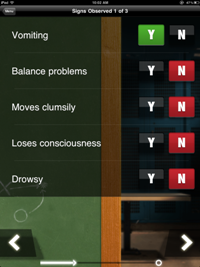Concussion Apps for Coaches and Parents: Will They Affect You?
If you opened a patient’s file before ordering or reading a CT or MRI scan and saw a note from a sideline coach saying the patient exhibited all the signs and symptoms of a concussion, what would you think? Would you be surprised?
If you opened a patient’s file before ordering or reading a CT or MRI scan and saw a note from a sideline coach saying the patient exhibited all the signs and symptoms of a concussion, what would you think? Would you be surprised?
You might have to get used to these notes thanks to iPad and smartphone technology. Radiology applications (apps) are becoming more common, but the concussion apps are unique. They aren’t designed for you, the radiologist. They’re meant for coaches, trainers, and parents.
“These apps aren’t designed to diagnose a concussion,” said Jason Mihalik, Ph.D., assistant professor of exercise and sports science at the University of North Carolina at Chapel Hill. “But they do put into the hands of coaches or parents the ability to assess whether an athlete who’s been hit in the head is showing signs and symptoms of such an injury.”
Mihalik and his colleagues developed a smartphone app that presents concussion signs and symptoms as a checklist. Based on the user’s answers, the app can recommend seeking physician attention for the athlete. Cleveland Clinic biomedical engineer Jay Alberts also created an app for the iPad2 that records a baseline assessment of an athlete’s cognitive, balance, vision, and motor skills. This information can be compared to athlete performance anytime he or she sustains a head injury. Both apps offer the option to email information to a parent or health care provider.
The radiology community disagrees, though, about whether these apps will be helpful. According to Asim Choudhri, M.D., a neuroradiologist at Le Bonheur Children’s Hospital in Memphis, the technology will likely mean more people will seek medical attention. In addition, if the app uses up-to-date clinical guidelines, the details it gathers could help determine which scans you recommend.
“These apps can serve as a guide for different clinical signs and help you decide which test is most appropriate,” Choudhri said. “It will also be helpful to see the history of what happened to the patient and the specifics of what behaviors they exhibited when you look at the CT or MRI scan.”

However, the information is only as good and useful as the person putting it in the app, said Elliott Fishman, M.D., director of diagnostic imaging and body CT at Johns Hopkins Hospital. While checklists and baseline assessments are effective tools in theory, he said, if the user puts in faulty details about a patient’s condition, then the information is useless.
“This technology could be good in the right hands, and really simplistic questions about a patient’s actions can greatly help us as providers,” Fishman said. “But the coach or parent answering questions has to be able to correctly assess things like slurred speech or double vision. Not everyone is qualified to do that, and it could lead to giving providers inaccurate information.”
Insurance companies could also create a problem with these apps. It’s possible, Choudhri said, that insurance companies will balk at considering details conveyed through the app as pre-certification for any diagnostic imaging scans, making it more difficult to get scans approved or for you to receive reimbursement.
GE HealthCare Debuts AI-Powered Cardiac CT Device at ACC Conference
April 1st 2025Featuring enhanced low-dose image quality with motion-free images, the Revolution Vibe CT system reportedly facilitates improved diagnostic clarity for patients with conditions ranging from in-stent restenosis to atrial fibrillation.
The Reading Room Podcast: Current Perspectives on the Updated Appropriate Use Criteria for Brain PET
March 18th 2025In a new podcast, Satoshi Minoshima, M.D., Ph.D., and James Williams, Ph.D., share their insights on the recently updated appropriate use criteria for amyloid PET and tau PET in patients with mild cognitive impairment.